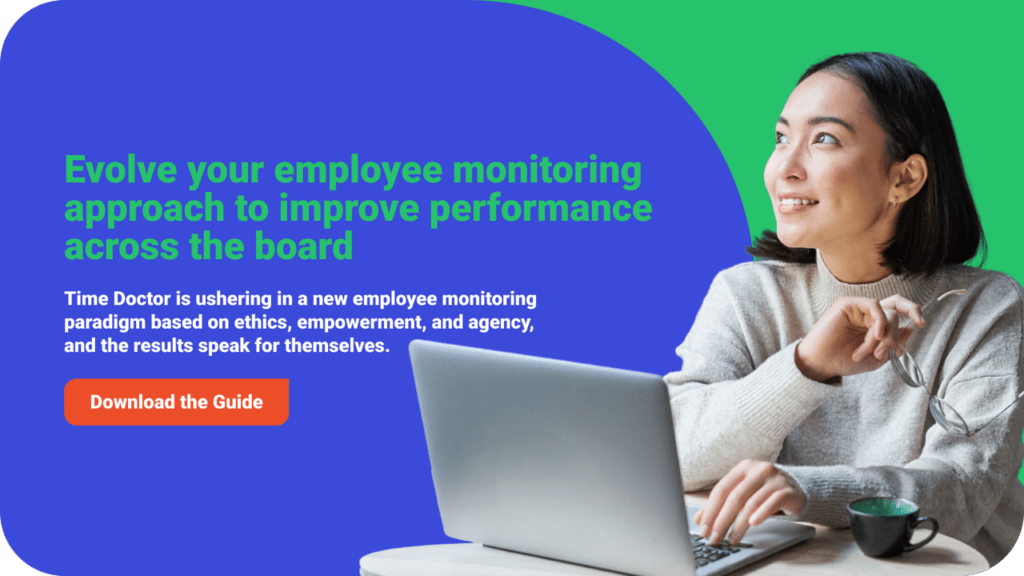We’ve all become familiar with the phrase “unprecedented times”. You might even say it’s been overused. But if there’s one cohort in the corporate world that knows what the phrase really means, it’s managers.
Remote work is booming. Demand for decentralized offices is sky-high. Good people are leaving unexpectedly. Up to 60% of employees are on the fence about their jobs or on their way to checking out.
At every level and sector, managers are swimming in uncharted waters.
Some might feel like they’re captaining the Titanic. But others appear like ducks on a pond: calm on the surface while working hard to maintain momentum. It’s this latter group we’re looking at as we examine the changes currently rippling through the world of work and try to predict how it’ll all wash out.
Ok, enough with the maritime metaphors. Let’s talk modern management.
Transitioning to the new era of management
Traditional management is hierarchical and vertical. Based on ideas of organization and control, the goal is to produce predictable short-term results. In other words, compliance.
This type of leadership can’t be comfortable for managers. So much of the day is spent checking up on employees and ensuring procedures are followed. There’s no room for strategic thinking.
It’s definitely not comfortable for employees. The stress of not slipping up takes a heavy toll on mental and physical health.
Unfortunately, employees in traditional organizations have learned that mimicking their managers’ approach is a pathway to success, so the behavior persisted for longer than it should have.
Because here’s the thing about traditional management: it’s not efficient anymore. It might have worked in the relative isolation of a single manufacturing plant, but the modern workplace has evolved. It’s time management styles did the same.
Defining the new paradigm of management
Several management styles emerged in the last 40-50 years that are our foundation for a stress-free future of work. Rather than enforcing compliance, these approaches focus on building trust in the workplace. Employees enjoy more agency, managers have more time for strategy, and companies benefit from higher productivity and greater innovation.
You might have heard of some of the emerging styles.
- Agile management, based on the idea of iterative development and continuous improvement.
- Lean management, focusing on eliminating waste and inefficiency to deliver value to customers.
- Leadership 3.0, where leaders create a shared vision and get out of the way so employees can achieve it.
- Servant leadership, which encourages leaders to put the needs of their team first with the understanding that engaged employees are more productive.
Each approach has its pros, cons, and ideal use cases. We won’t dive into each one here. If you’re interested in learning more, the Time Doctor blog has helpful guides to many new-age management styles.
More important than the specifics is the underlying philosophy uniting these approaches. They are all based on the idea that employees are more motivated and productive when they feel trusted, supported, and valued as part of a team.
These conditions contribute to improving employee engagement, which is arguably the most important measure of success for managers today.
- Engaged employees are 23% more profitable (source)
- Customer loyalty improves by 10% with an engaged workforce (source)
- Disengaged employees cost the company 18% of their salary in lost productivity (source)
- Turnover falls 18-43% when employees are engaged (source)
Forget about top-down task-based metrics. Boosting employee engagement is the single most important thing you can do as a manager to thrive in the era of distributed and globalized work.

The harmony between oversight and autonomy
The same autonomy that enables employees to thrive can make managers nervous. In our quest for a stress-free workplace, we need to resolve this dissonance so both parties have peace of mind.
How to give autonomy without losing touch
Managers need to be able to track employee performance and ensure that work is getting done. On the other hand, employee engagement depends on having the freedom to do great work.
Getting the balance right starts with reassessing employees’ needs in a distributed workplace and reaffirming their contribution to organizational growth targets.
In practice, this means:
- Establishing a link between daily tasks and organizational growth
- Rethinking KPIs to set relevant, measurable and constructive targets
- Being transparent with employees about the purpose, nature and outcomes of changes
- Looking at shortcomings as opportunities to support growth rather than failures to be punished
- Democratizing employee productivity data to encourage accountability
- Analyzing holistic performance rather than focusing on short-sighted metrics
Modern monitoring software gives managers access to many of the workday insights they need to kick off these conversations. But it’s what they do with those insights that makes a difference in employee engagement.
Modern techniques vs traditional management
In the old world of compliance, managers might have assessed an employee’s performance against arbitrary targets like productive time at a computer and adjusted their pay accordingly. Aside from the obvious – upsetting employees – this approach has several fatal flaws:
- Work-life balance was absent from the picture, so the scales tipped the wrong way
- Not all work happens in front of a computer or workstation
- Employees fear they could be penalized for going to the bathroom, taking a colleague’s call or getting up to answer the door
- Productive minutes don’t consider value added; employees were seen to take longer on tasks when they didn’t trust their managers
- Employees might edit timesheets to maintain a clean record rather than challenge time misclassified as unproductive
Modern monitoring looks at employee productivity metrics as a way to identify growth and learning opportunities. The tools support managers who understand that employees are humans, and humans are flawed but able to do great things in the right conditions.
In fact, an ethical approach to employee monitoring has been shown to increase revenue by 7%. We believe that potential arises from the combination of employee accountability and managers better understanding what their people need.
You can read more about the evolution of employee monitoring in our recent article, Rethinking Monitoring: A Fresh Approach for Modern Teams.
Building teams that thrive, not just survive
The global economy is emerging from a period where all we could do was hold on and hope for the best. What’s starting to crystallize is the difference in performance and employee engagement between companies that navigated the choppy waters with a traditional approach and those that took the opportunity to evolve.
After analyzing the performance of 1,800 companies in 15 countries, McKinsey found that performance-driven organizations saw an average of 13.4% turnover from 2010-2019. People-focused companies had the lowest average of 7.9%, only a little ahead of people-and-performance-focused companies at 8.5%.
But considering all metrics, including revenue growth during the pandemic, employees’ upward mobility, overall economic profit, and likelihood to outperform competitors, ‘people and performance’ companies won the day convincingly.
How do these companies do it?
The group McKinsey identifies as ‘people and performance’ companies “excel at creating opportunities for their employees to build skills”.
In contrast, performance-focused organizations “achieve top-tier financial results but do not put the same kind of emphasis on skills development and the work environment”, while people-focused companies “put resources into developing employees but are unable to translate that into strong financials”.
These organizations in the Goldilocks zone have identified the long-term benefit of developing employees’ skills. Rather than reducing employees to task-based outputs, they play to people’s strengths, giving employees autonomy and agency.
These businesses exhibit the hallmarks of modern management, where long-term goals, transparent productivity data and an improvement-focused mindset create the conditions for organizational growth. As a result, they are better prepared to meet the changing needs of both employees and organizations.
Dive deeper into ethical employee monitoring
Employee monitoring is a key enabler of stress-free work. Productivity data helps build trust in the workplace while providing holistic oversight of team activity.
Effective employee monitoring is collaborative, transparent and focused on improvement. Where the ‘old guard’ zeroed in on short-sighted output metrics, modern approaches to ethical employee monitoring use employee productivity metrics to guide growth decisions, tailor employee support and prevent burnout.
Download our Guide to Improvement-Focused Employee Monitoring to take an in-depth look at how monitoring has changed, plus practical tips to evolve your organization’s approach.
Trust is the cornerstone of modern management
The ability to build trust in the workplace was well and truly put to the test in the rapid and widespread shift to remote work.
Managers had to decide if they trusted their teams to work remotely. Most didn’t.
Employees had to trust that leaders would make the right decisions in a crisis. Most didn’t.
Gallup found that employees’ trust in leadership is faltering in 2023. Less than one in four workers (21%) trust the people running the show, down from 24% in 2019.
This trust gap coincides with historically low employee engagement and the historically high prevalence of remote work. These conditions aren’t mutually exclusive. They’re entirely interdependent, and that causes a great deal of stress in the workplace.
The trust trifecta
Gallup puts the behaviors that build trust in the workplace into three categories:
- Lead and support change
- Communicate clearly
- Inspire confidence in the future
Leaders who are strong in all three areas earn full trust from 95% of their employees. So, let’s break down the steps you can take to build trust and drive performance.
- Lead and support change
Almost overnight, managers everywhere went from in-person interactions to remote work, and most have been left to fend for themselves ever since.
Nearly two-thirds of hybrid managers (57%) say they have not received any training to manage the hybrid work environment. Only 7% received structured training, while another 19% had the option to take a course, and the remaining 15% were helped along with informal advice.
As much as employees need two-way communication with managers, managers need two-way communication with top-level leaders. Establishing these lines of dialogue looks like:
- Defining and articulating the company’s vision for change
- Involving enough of the right people in change management planning
- Maintaining frequent communications
- Celebrating milestones
- Linking daily operations to long-term changes
Employees who feel they have an opportunity to contribute to organizational change and provide honest feedback are significantly more likely to trust their leaders.
- Communicate clearly
Every relationship is built on communication. The modern workplace is no exception. Employees who feel their manager is a sub-par communicator are 23% more likely to experience poor mental health.
It’s interesting to note that 49% of employees don’t know what’s expected of them. That figure has come down since peaking at 55% in 2022, but it’s still far above the pre-pandemic level of 39%.
Why is communication degrading when we’re seemingly active on more tools, platforms and devices than ever? Well, it’s more likely the quality of communication than the quantity.
In particular, a sense of purpose and group effort seems to be absent from communications. Employees have lost sight of what their colleagues are working on, limiting their perspective to about arm’s length, the distance to the computer screen.
Managers need to weave purpose and context into communication at every opportunity:
- Link tasks and projects to organizational goals
- Establish cross-functional communication channels for collaboration
- Analyze productivity data to have more constructive check-ins
- Focus feedback on employee development, not short-term targets
- Give employees a say in strategic decisions
Most importantly, managers need to communicate frequently and transparently. Especially when introducing a big change like employee monitoring software, maintaining open and honest dialogue is crucial to getting everyone on the same page.
- Inspire confidence in the future
Leading through change is hard enough without losing the trust of your people in the process. However, unlike the other two factors, this one is almost entirely down to managers alone.
According to Gallup, “only 18% of employees strongly agree that their leaders help them see how changes made today will affect their organization. And just two in 10 feel highly confident in their leaders to manage emerging challenges.”
That’s not reassuring.
Nor is it surprising.
If you want to inspire confidence, you need to create opportunities for employees to contribute. This dovetails with the idea that employees feel a sense of agency when they are involved in decisions and autonomy when empowered to make their own choices.
- Lay out the plan
- Detail the steps to get there, as far as you know them
- Acknowledge and celebrate milestones
- Ask employees for input
- Give and receive constructive feedback
Trust goes both ways. Managers who are asking for their team to follow them into uncharted territory must in return trust their people to contribute to the journey.
Harnessing the power of modern tools
If there’s one thing to take away from the discussion around new-age management, it’s that work is evolving, not revolving. The world of work has moved on from top-down, compliance-driven operations and is now global, democratic and decentralized.
It’s also much more human.
Human-centric technology is one of the most powerful tools for modern managers in this stress-free future of work. From employee monitoring software that respects privacy to communication tools that enhance collaboration, the right tech makes work more transparent while improving productivity at the same time.
Communication and collaboration tools
The expansion and integration of leading tools like Slack, G Suite and Miro enable teams to stay connected, collaborate seamlessly, and work asynchronously. These tools – and there are many more we didn’t name – remove the barriers to decentralized work, and are always improving to make collaboration more intuitive.
Modern managers can use them to maintain open lines of communication, ensuring employees can easily reach out when needed.
Productivity analytics tools
Modern managers harness the power of data to analyze performance on several fronts, including customer feedback, employee productivity and market trends. By making informed decisions, organizations can adapt quickly to changing circumstances and seize opportunities.
In particular, employee monitoring software helps managers find that all-important balance between oversight and autonomy, keeping employees on task without letting them get overwhelmed. The best solutions like Time Doctor also promote work-life balance by flagging the early signs of burnout so managers can intervene.
Project management tools
Platforms like Asana, Teams and Jira, among many others, help streamline project management while making communication more transparent.
Since nearly 50% of people don’t know what managers expect from them, it’s more important than ever to create detailed project plans and stay on top of task assignments.
Automation and AI tools
Generative AI might be having a moment in the sun, but proactive managers have been using a different kind of AI for years to alleviate the stress of repetitive work. Most AI is built into business systems, so it’s hard to see. It just works.
The biggest benefit comes from automating time-consuming tasks like data entry, simple customer support and back-office admin, allowing employees to focus on more meaningful strategic work.
Lead your team in the stress-free future of work
Managers who try to navigate change using management methods that have been out of touch for decades are effectively stumbling around in the dark. They’re bound to end up bumping into walls.
Avoiding the headaches of managing through change requires an adaptive approach using modern techniques and human-centric employee productivity monitoring. Communication, collaboration and continuous improvement are the foundation for growth in the new era of improvement-focused leadership.
It’s not always an easy transition for managers. Traditional approaches have had over two centuries to metastasize. Shaking them off requires a fundamental reassessment of the purpose, function and form of management to create a stress-free work environment.
Rest assured that Time Doctor is right there with you. We are committed to providing ethical employee monitoring tools to give employees, managers and organizations greater agency to make positive changes.
| Download our guide to ethical employee monitoring to get a practical toolkit for transitioning to a stress-free management style defined by collaboration, continuous improvement and transparency. |

Carlo Borja is the Content Marketing Manager of Time Doctor, a workforce analytics software for distributed teams. He is a remote work advocate, a father and a coffee junkie.


